You know that feeling when you press the brakes and hear that annoying clicking noise. It’s not only frustrating, but it can also make you feel uncertain about the safety of your vehicle.
So, what causes the clicking noise when braking?
Well, it may occur when your brake pads are worn or damaged. Additionally, a clicking noise can be caused by dirty or contaminated brake pads or worn or damaged brake calipers. Loose or damaged brake hardware and worn, wrapped or damaged brake rotors may also be the culprits.
Don’t let a clicking noise when braking put your safety at risk. Read on to learn how to fix the problem, and keep your vehicle running smoothly.
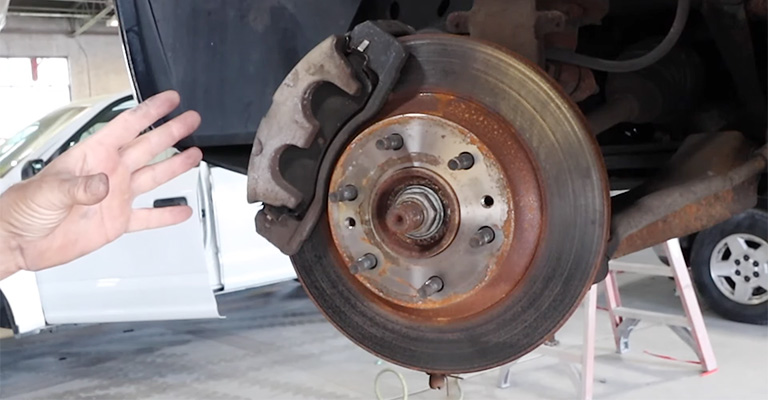
Road Test to Identify the Location of the Noise
As the vehicle has several brake points, you must first identify where the noise comes from. A road test might be the solution to identify the noise location(s).
Here are the steps to conduct a road test:
- Step 1: Start by driving your vehicle in a safe area, such as a deserted parking lot or a quiet residential street
- Step 2: Apply the brakes at different speeds and from different directions
- Step 2: Pay attention to where the noise comes from and if it changes with different braking conditions
- Step 3: Take note of any other symptoms that may be present, such as vibrations or pulling to one side while braking
- Step 4: Repeat the test a few times to understand the noise location and conditions clearly
Clicking Noise When Braking: What are the Causes?
Here is what is making your brakes click when you press the pedal:
1. Dirty or Contaminated Brake Pads
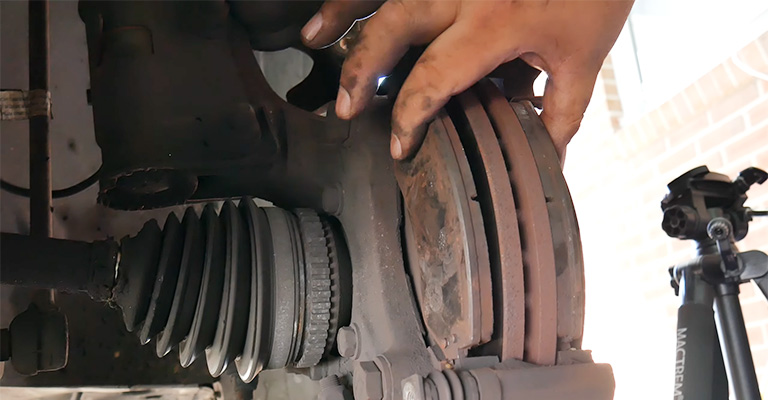
Contaminants, such as dust, dirt, oil, or rust, can accumulate on the surface of the brake pads over time. This can cause them to become less effective at stopping the vehicle and lead to various problems, including a clicking noise when braking.
2. Worn or Damaged Brake Calipers
The brake calipers are responsible for applying pressure to the brake pads, which press against the rotors to slow or stop the vehicle. If the calipers become worn or damaged, they may not function properly and can cause various issues, including a clicking noise when braking.
The brake calipers may not apply the correct pressure to the brake pads. This can cause the brake pads to move around within the caliper and create noise.
3. Loose or Damaged Brake Hardware and Hub Cup
Brake hardware refers to the various components that hold the brake pads in place, such as the caliper bolts, brake pad clips, hub cups, and shims. These components play an important role in maintaining the proper alignment and function of the brake pads.
When brake hardware becomes loose, it can cause the brake pads to move around within the caliper. This can lead to a clicking noise when braking as the pads are unstable and make contact with the rotor inconsistent.
4. Worn or Damaged Brake Rotor
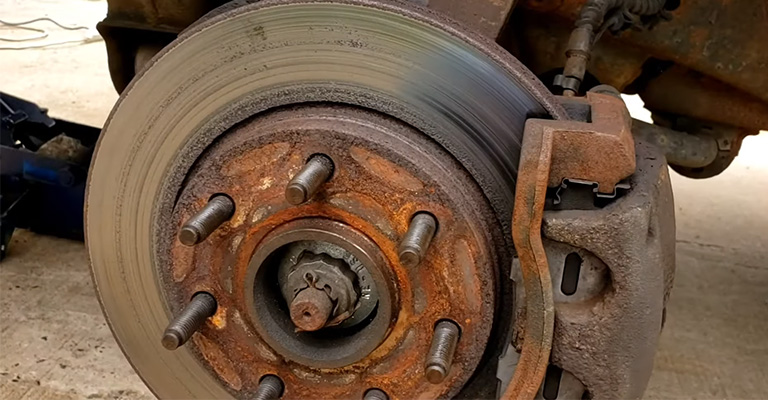
The brake rotors are the discs the brake pads press against to slow or stop the vehicle. When the rotors become worn or damaged, they can cause the brake pads to make inconsistent contact with the rotor, leading to a clicking noise when braking.
5. Worn-out Brake Pads
As the brake pads wear down, the friction material on the pads is depleted. This can cause them to be less effective at stopping the vehicle and can lead to a clicking noise when braking. This noise is caused by the metal backing plate of the brake pad making contact with the rotor.
6. Bent Brake Plates
The brake backing plate is a metal plate that sits behind the brake pads and provides a surface for the brake pads to press against when the brakes are applied. If the backing plate is bent, it can cause the brake pads to make contact with the rotor at an angle, which can cause a clicking noise.
7. Improper Brake Parallelism
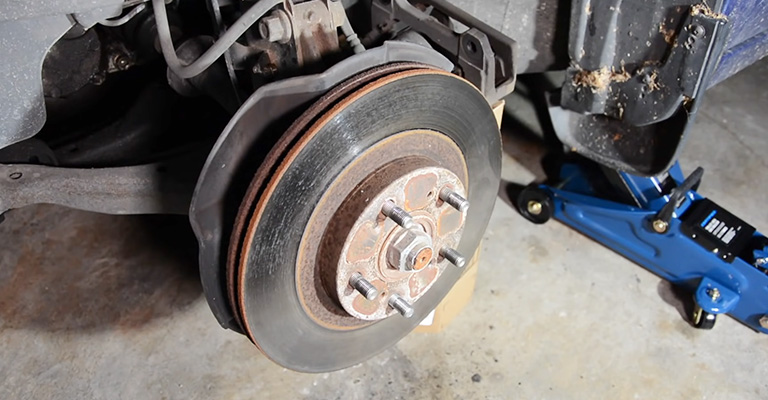
Brake parallelism refers to the alignment of the brake pads in relation to the rotor. If the brake pads are not parallel to the rotor, it can cause breaking parts to make contact with the rotor at an angle, which can cause a clicking noise.
Improper brake parallelism can occur due to worn or damaged suspension components, improper installation, or worn-out steering and suspension.
Step-by-Step Guide on How to Fix Click Noise When Braking
Here is a guide on how to fix this issue:
1. Gather Tools and Supplies
To fix the click noise when braking, you will need the following tools and materials:
- Jack and jack stands
- Lug wrench
- Brake cleaner
- Brake pad hardware kit (if necessary)
- Replacement brake pads (if required)
- Gloves
- Torque wrench (if replacing brake pad hardware)
2. Jack Up the Vehicle and Remove the Wheel
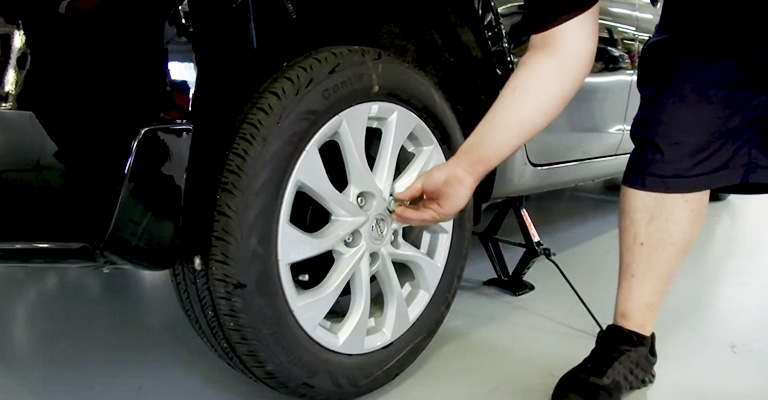
You will need a jack and jack stand to jack up the vehicle. The jack lifts the car off the ground, and the jack supports it securely while you work on the brake system.
Here is the procedure to jack up the vehicle:
- First, ensure the car is parked, and the emergency brake is engaged
- Locate the jacking points on your automobile, usually indicated by small notches near the wheels
- Place the jack under the car at the jacking point and raise the vehicle off the ground
- Once the vehicle is high enough, place the jack stands under it and adjust them to support it securely
- Make sure the automobile is stable and not shaky before removing the wheel
- Use the lug wrench to remove the nuts and take the wheel off
3. Inspect the Brake Pads and Rotor
This is important to identify the cause of the noise and determine if any components need to be replaced or cleaned.
To inspect the brake pads, look for signs of wear, such as thinning or grooving. The brake pads should be of a certain thickness; if worn down to a dangerous level, they should be replaced.
To inspect the rotor, look for any signs of damage, such as warping or grooving. The rotor should be smooth, and even if it is damaged, it should be replaced.
It should be cleaned if the rotor has rust or debris on it. A rotor that is not smooth can cause vibration, noise, and uneven braking.
4. Inspect Brake Calipers

To do this, locate the brake calipers behind your vehicle’s wheels. Use a flashlight to inspect them visually.
Look for any signs of cracking or missing chunks of friction material. Inspect the brake calipers for any signs of leaks or damage. Take note of any issues you find during the inspection, such as worn or damaged pads, calipers, or hardware.
5. Replace and Tighten any Loose Hardware
Replace any damaged or missing hardware to ensure the brake pads are securely in place. Tightening any loose hardware will also help to prevent noise. Make sure to follow the manufacturer’s recommended torque specifications when tightening hardware.
6. Measure Rotor Thickness, Parallelism and Check for Warping
To measure the rotor thickness, you will need a micrometer. Here are the steps:
- Use a micrometer to measure the thickness of the rotor at several points around the rotor.
- Compare the measurements to the minimum thickness specified by the vehicle manufacturer.
- Check for warping by measuring the thickness at the outer and inner edges of the rotor. If there is a difference in measurement, it may indicate distortion.
If the rotor is below the minimum thickness as stated in your car manual or shows signs of warping, it will need to be replaced or resurfaced.
The following video will visually help you to measure the rotor’s thickness.
How to Clean the Brake Pads and Rotor?
If the brake pads and rotors are not damaged, simply cleaning them could be fine.
You will need a brake cleaner and a clean rag to clean the brake pads and rotor. Brake cleaner is a specialized solvent designed to remove brake dust and other contaminants from the brake pads and rotor.
Here is the procedure to clean the brake pads and rotor:
- Spray the brake cleaner on a clean rag and use it to wipe down the brake pads, removing any dirt or debris
- Spray the brake cleaner directly on the rotor and use the rag to wipe it down, removing any rust or debris
- Use a clean rag to dry the rotor and brake pads
- Repeat this process if necessary until the rotor, and brake pads are clean
Using a brake cleaner specifically designed for brake components is essential, as some solvents can damage or erode the brake pads and rotor.
Conclusion
By following the steps outlined in this article, you can diagnose and fix the click noise when braking. Regular brake maintenance is also important to ensure that your brakes are in good working order to avoid the issue in the future. This includes regularly inspecting the brake pads, rotor, and hardware for wear or damage and replacing or cleaning them as needed.
It is also important to follow the vehicle’s recommended maintenance schedule and have the brakes inspected and serviced as needed. This can help prevent issues such as worn brake pads, dirty rotors, and loose hardware, which can all contribute to noise and reduced braking performance.

Leave a Reply